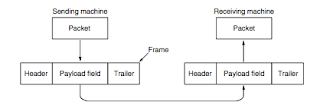- Data link layer uses services of the physical layer to send and receive bits over communication channels
- provide a well defined service interface to the network layer
- deal with transmission errors
- regulate flow of data so that slow receivers are not swamped by fast senders
- data link layer takes packets and encapsulates them into frames for transmission
Services Provided to the Network Layer
- function is to provide services to the network layer
- path data takes shown below
- offers various services
- unack connectionless service
- source machine send independent frames to destination machine
- ack connectionless service
- WiFi (802.11)
- ack connection oriented service
- most sophisticated, source and destination establish reliable data link
Framing
- in order to provide services to network layer, it must use the services provided by the physical layer
- must break up the bit steam using
- Byte Count
- uses a field in the header to specify number of bytes in frame
- can be garbled by transmission error
- rarely used on its own
- Flag Bytes with byte stuffing
- flag bytes used as starting and ending delimiters
- byte stuffing
- sender's data link layer insert a special ESC(escape byte) before each accidental flag byte
- following is an example used in PPP(Point to Point protocols)
- Flag Bits with bit stuffing
- gets around byte stuffing disadvantage that it is tied to 8 bit bytes
- can contain arbitrary bits developed for HDLC(High Level Data Link Control Protocol)
- Physical Layer coding violations
- is a shortcut from the physical layer
- if we do 4B/5B we don't need to map to all possible symbols so the unused signals are violations that signal an error
Error Control
- mark the start and end now we have to see if delivery is in order
- provide sender with some feedback
- introduce timers into data link layer, starts a time so that frame is set to expire
- this way sender knows if frame has been lost
- issue to manage timers
Flow Control
- what to do when a sender wants to transmit frames faster than receiver can accept them
- two approaches are commonly used
- feedback-based flow control receiver sends information to sender to give permission to send
- rate based flow control, built in mechanism to limit rate of sending
- NIC(Network Interface Cards)
- can handle frames as fast as they can arrive so overruns aren't a problem




No comments:
Post a Comment